Report: Operations Management of Logistics and Supply Chain Analysis
VerifiedAdded on 2020/03/13
|12
|2562
|47
Report
AI Summary
This report provides an executive summary, literature review, and analysis of an article on Operations Management of Logistics and Supply Chain. The report discusses the importance of supply chain management (SCM) and its impact on business efficiency, emphasizing concepts like "buy, produce, sell, collect, and pay." It explores the significance of inventory and transportation management in reducing inefficiencies, and the role of intermodal connectivity and vehicle routing planning (VRP). The report addresses key questions about channel management, logistics objectives, and the integration of various management aspects. It highlights the importance of efficient distribution, strategic inventory management, and transportation planning. The report concludes with recommendations to automate and control management and transport processes, increase inventory visibility, and reduce costs through technology. The report emphasizes the need to optimize transportation operations for better decision-making and customer satisfaction.
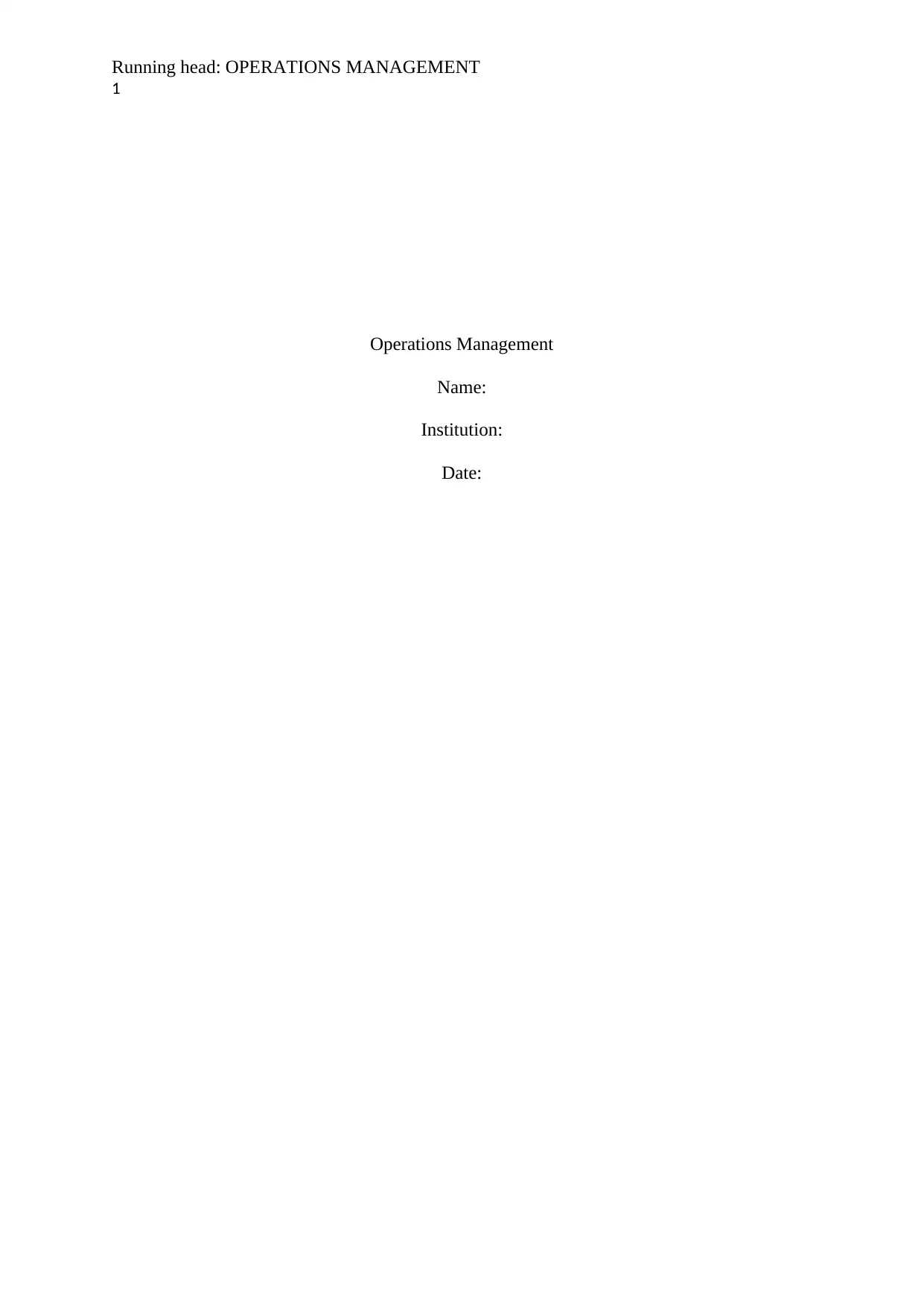
Running head: OPERATIONS MANAGEMENT
1
Operations Management
Name:
Institution:
Date:
1
Operations Management
Name:
Institution:
Date:
Paraphrase This Document
Need a fresh take? Get an instant paraphrase of this document with our AI Paraphraser

OPERATIONS MANAGEMENT 2
Operation management
Executive summary
Operation management
Executive summary
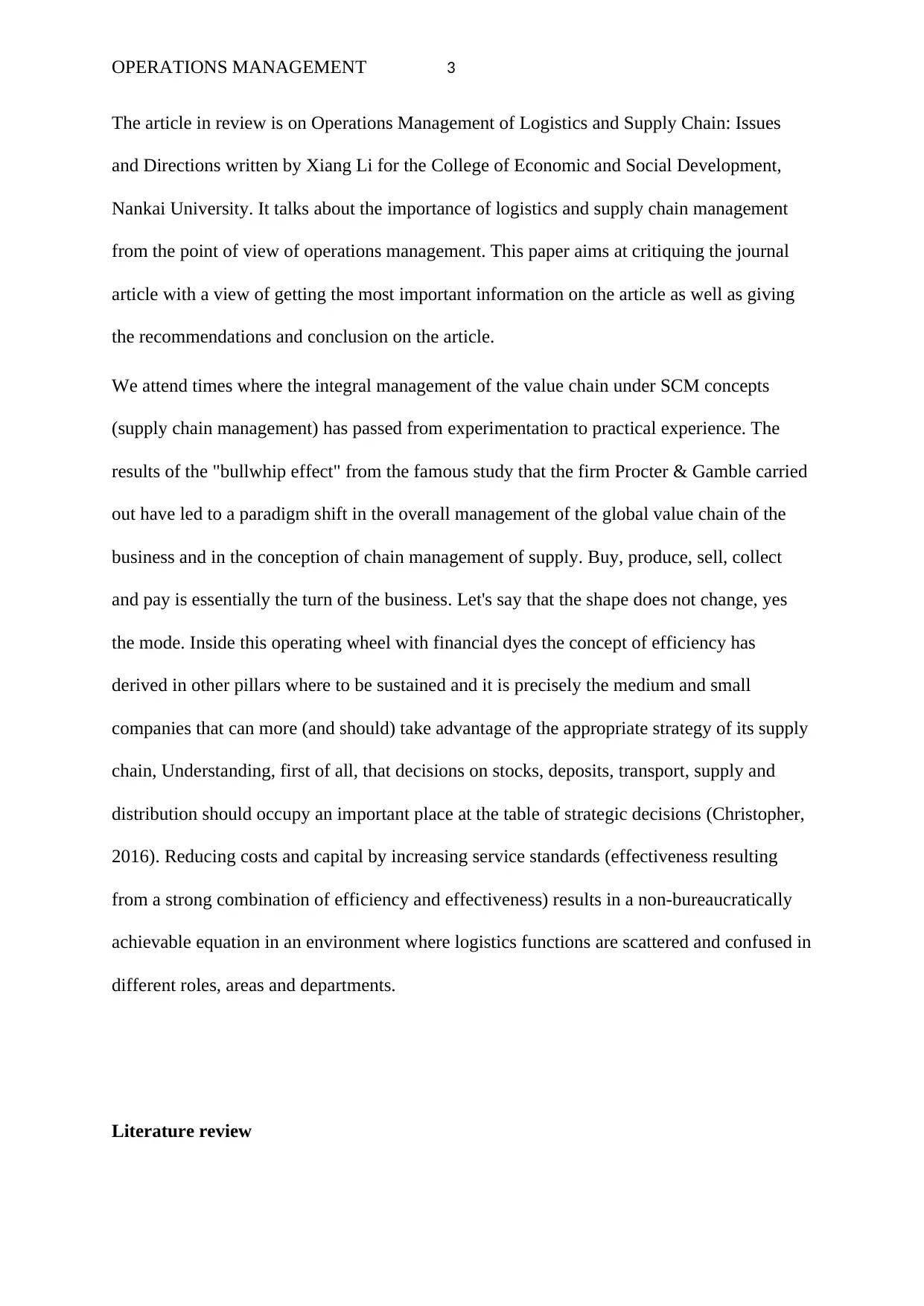
OPERATIONS MANAGEMENT 3
The article in review is on Operations Management of Logistics and Supply Chain: Issues
and Directions written by Xiang Li for the College of Economic and Social Development,
Nankai University. It talks about the importance of logistics and supply chain management
from the point of view of operations management. This paper aims at critiquing the journal
article with a view of getting the most important information on the article as well as giving
the recommendations and conclusion on the article.
We attend times where the integral management of the value chain under SCM concepts
(supply chain management) has passed from experimentation to practical experience. The
results of the "bullwhip effect" from the famous study that the firm Procter & Gamble carried
out have led to a paradigm shift in the overall management of the global value chain of the
business and in the conception of chain management of supply. Buy, produce, sell, collect
and pay is essentially the turn of the business. Let's say that the shape does not change, yes
the mode. Inside this operating wheel with financial dyes the concept of efficiency has
derived in other pillars where to be sustained and it is precisely the medium and small
companies that can more (and should) take advantage of the appropriate strategy of its supply
chain, Understanding, first of all, that decisions on stocks, deposits, transport, supply and
distribution should occupy an important place at the table of strategic decisions (Christopher,
2016). Reducing costs and capital by increasing service standards (effectiveness resulting
from a strong combination of efficiency and effectiveness) results in a non-bureaucratically
achievable equation in an environment where logistics functions are scattered and confused in
different roles, areas and departments.
Literature review
The article in review is on Operations Management of Logistics and Supply Chain: Issues
and Directions written by Xiang Li for the College of Economic and Social Development,
Nankai University. It talks about the importance of logistics and supply chain management
from the point of view of operations management. This paper aims at critiquing the journal
article with a view of getting the most important information on the article as well as giving
the recommendations and conclusion on the article.
We attend times where the integral management of the value chain under SCM concepts
(supply chain management) has passed from experimentation to practical experience. The
results of the "bullwhip effect" from the famous study that the firm Procter & Gamble carried
out have led to a paradigm shift in the overall management of the global value chain of the
business and in the conception of chain management of supply. Buy, produce, sell, collect
and pay is essentially the turn of the business. Let's say that the shape does not change, yes
the mode. Inside this operating wheel with financial dyes the concept of efficiency has
derived in other pillars where to be sustained and it is precisely the medium and small
companies that can more (and should) take advantage of the appropriate strategy of its supply
chain, Understanding, first of all, that decisions on stocks, deposits, transport, supply and
distribution should occupy an important place at the table of strategic decisions (Christopher,
2016). Reducing costs and capital by increasing service standards (effectiveness resulting
from a strong combination of efficiency and effectiveness) results in a non-bureaucratically
achievable equation in an environment where logistics functions are scattered and confused in
different roles, areas and departments.
Literature review
⊘ This is a preview!⊘
Do you want full access?
Subscribe today to unlock all pages.

Trusted by 1+ million students worldwide
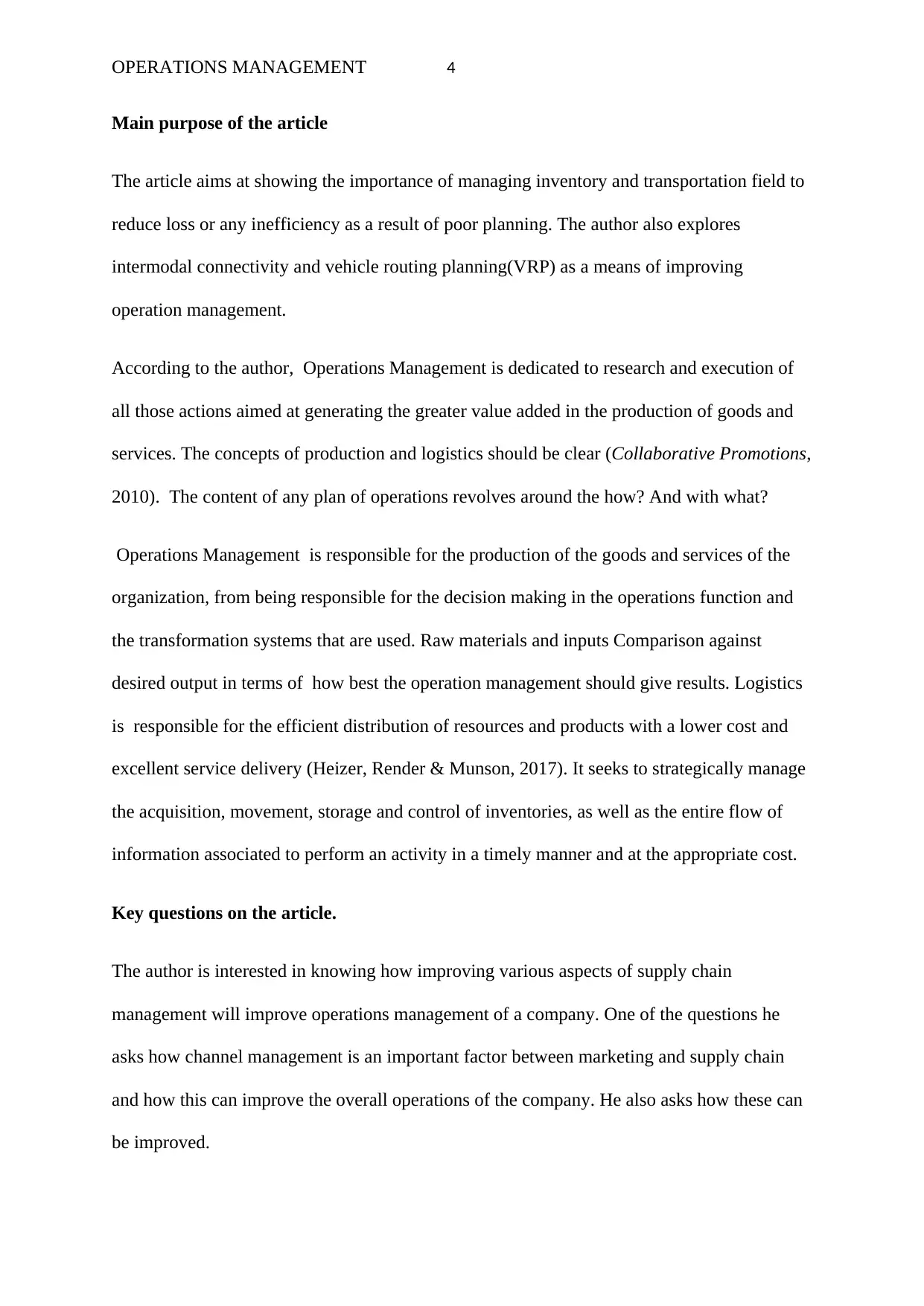
OPERATIONS MANAGEMENT 4
Main purpose of the article
The article aims at showing the importance of managing inventory and transportation field to
reduce loss or any inefficiency as a result of poor planning. The author also explores
intermodal connectivity and vehicle routing planning(VRP) as a means of improving
operation management.
According to the author, Operations Management is dedicated to research and execution of
all those actions aimed at generating the greater value added in the production of goods and
services. The concepts of production and logistics should be clear (Collaborative Promotions,
2010). The content of any plan of operations revolves around the how? And with what?
Operations Management is responsible for the production of the goods and services of the
organization, from being responsible for the decision making in the operations function and
the transformation systems that are used. Raw materials and inputs Comparison against
desired output in terms of how best the operation management should give results. Logistics
is responsible for the efficient distribution of resources and products with a lower cost and
excellent service delivery (Heizer, Render & Munson, 2017). It seeks to strategically manage
the acquisition, movement, storage and control of inventories, as well as the entire flow of
information associated to perform an activity in a timely manner and at the appropriate cost.
Key questions on the article.
The author is interested in knowing how improving various aspects of supply chain
management will improve operations management of a company. One of the questions he
asks how channel management is an important factor between marketing and supply chain
and how this can improve the overall operations of the company. He also asks how these can
be improved.
Main purpose of the article
The article aims at showing the importance of managing inventory and transportation field to
reduce loss or any inefficiency as a result of poor planning. The author also explores
intermodal connectivity and vehicle routing planning(VRP) as a means of improving
operation management.
According to the author, Operations Management is dedicated to research and execution of
all those actions aimed at generating the greater value added in the production of goods and
services. The concepts of production and logistics should be clear (Collaborative Promotions,
2010). The content of any plan of operations revolves around the how? And with what?
Operations Management is responsible for the production of the goods and services of the
organization, from being responsible for the decision making in the operations function and
the transformation systems that are used. Raw materials and inputs Comparison against
desired output in terms of how best the operation management should give results. Logistics
is responsible for the efficient distribution of resources and products with a lower cost and
excellent service delivery (Heizer, Render & Munson, 2017). It seeks to strategically manage
the acquisition, movement, storage and control of inventories, as well as the entire flow of
information associated to perform an activity in a timely manner and at the appropriate cost.
Key questions on the article.
The author is interested in knowing how improving various aspects of supply chain
management will improve operations management of a company. One of the questions he
asks how channel management is an important factor between marketing and supply chain
and how this can improve the overall operations of the company. He also asks how these can
be improved.
Paraphrase This Document
Need a fresh take? Get an instant paraphrase of this document with our AI Paraphraser
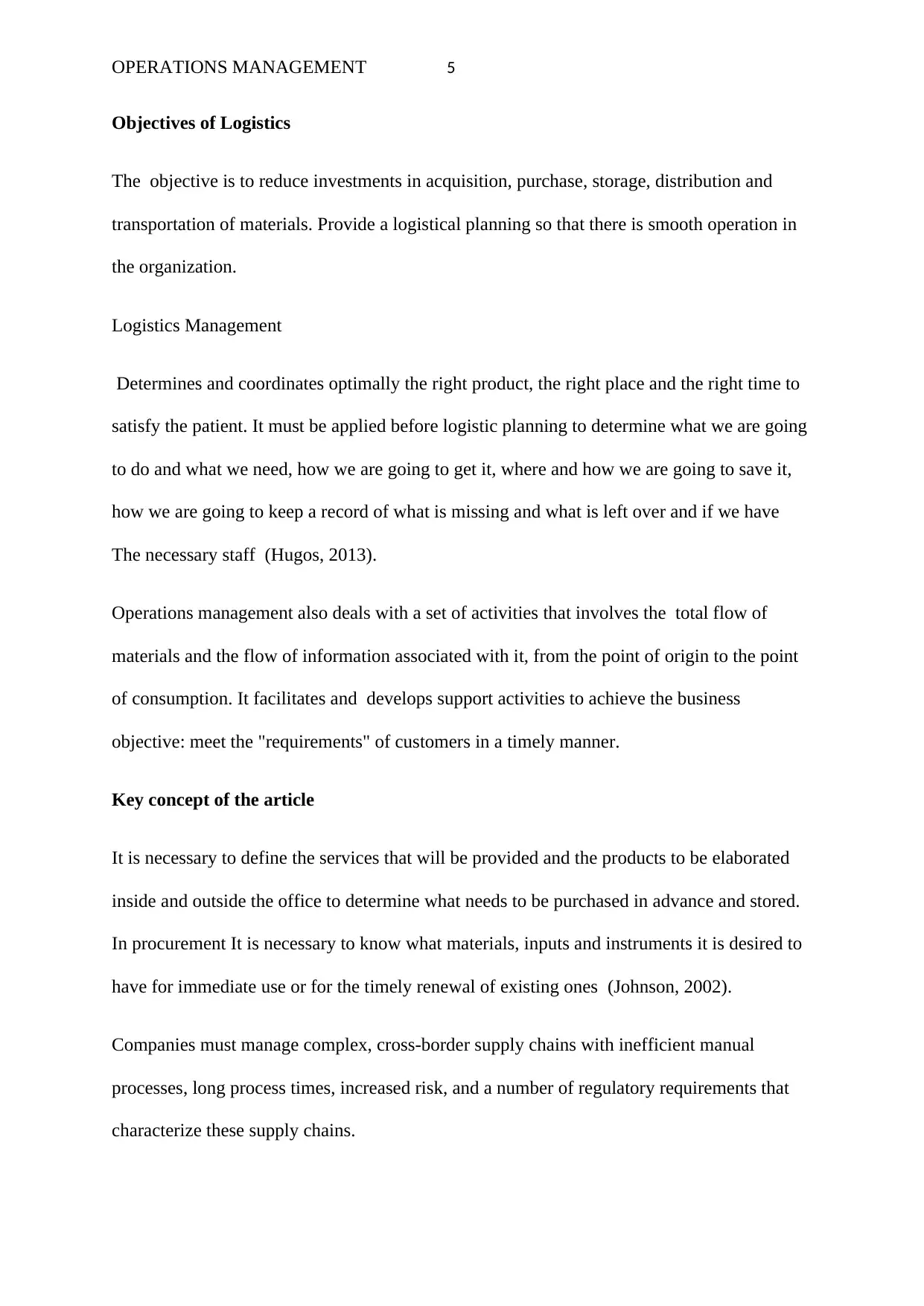
OPERATIONS MANAGEMENT 5
Objectives of Logistics
The objective is to reduce investments in acquisition, purchase, storage, distribution and
transportation of materials. Provide a logistical planning so that there is smooth operation in
the organization.
Logistics Management
Determines and coordinates optimally the right product, the right place and the right time to
satisfy the patient. It must be applied before logistic planning to determine what we are going
to do and what we need, how we are going to get it, where and how we are going to save it,
how we are going to keep a record of what is missing and what is left over and if we have
The necessary staff (Hugos, 2013).
Operations management also deals with a set of activities that involves the total flow of
materials and the flow of information associated with it, from the point of origin to the point
of consumption. It facilitates and develops support activities to achieve the business
objective: meet the "requirements" of customers in a timely manner.
Key concept of the article
It is necessary to define the services that will be provided and the products to be elaborated
inside and outside the office to determine what needs to be purchased in advance and stored.
In procurement It is necessary to know what materials, inputs and instruments it is desired to
have for immediate use or for the timely renewal of existing ones (Johnson, 2002).
Companies must manage complex, cross-border supply chains with inefficient manual
processes, long process times, increased risk, and a number of regulatory requirements that
characterize these supply chains.
Objectives of Logistics
The objective is to reduce investments in acquisition, purchase, storage, distribution and
transportation of materials. Provide a logistical planning so that there is smooth operation in
the organization.
Logistics Management
Determines and coordinates optimally the right product, the right place and the right time to
satisfy the patient. It must be applied before logistic planning to determine what we are going
to do and what we need, how we are going to get it, where and how we are going to save it,
how we are going to keep a record of what is missing and what is left over and if we have
The necessary staff (Hugos, 2013).
Operations management also deals with a set of activities that involves the total flow of
materials and the flow of information associated with it, from the point of origin to the point
of consumption. It facilitates and develops support activities to achieve the business
objective: meet the "requirements" of customers in a timely manner.
Key concept of the article
It is necessary to define the services that will be provided and the products to be elaborated
inside and outside the office to determine what needs to be purchased in advance and stored.
In procurement It is necessary to know what materials, inputs and instruments it is desired to
have for immediate use or for the timely renewal of existing ones (Johnson, 2002).
Companies must manage complex, cross-border supply chains with inefficient manual
processes, long process times, increased risk, and a number of regulatory requirements that
characterize these supply chains.
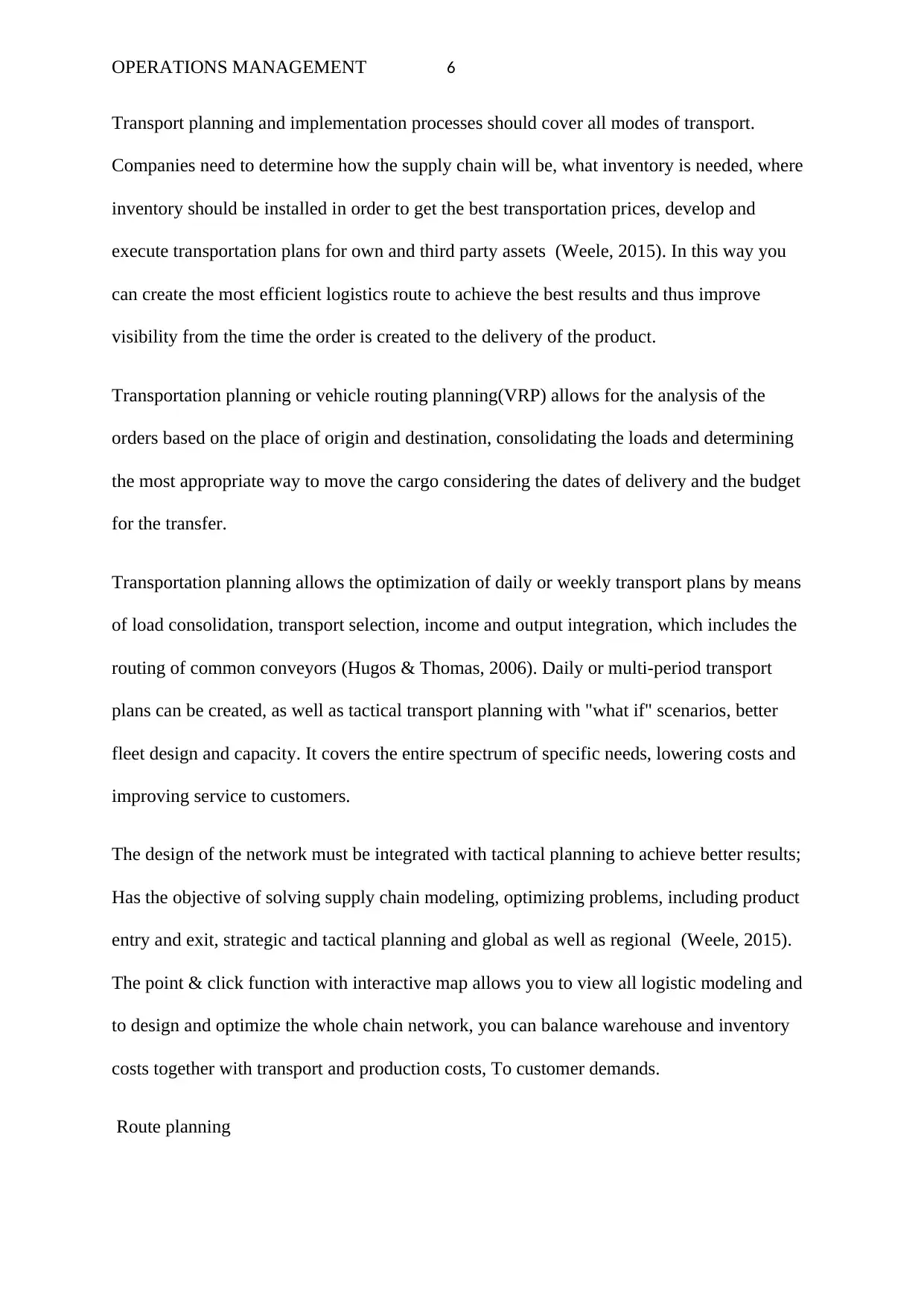
OPERATIONS MANAGEMENT 6
Transport planning and implementation processes should cover all modes of transport.
Companies need to determine how the supply chain will be, what inventory is needed, where
inventory should be installed in order to get the best transportation prices, develop and
execute transportation plans for own and third party assets (Weele, 2015). In this way you
can create the most efficient logistics route to achieve the best results and thus improve
visibility from the time the order is created to the delivery of the product.
Transportation planning or vehicle routing planning(VRP) allows for the analysis of the
orders based on the place of origin and destination, consolidating the loads and determining
the most appropriate way to move the cargo considering the dates of delivery and the budget
for the transfer.
Transportation planning allows the optimization of daily or weekly transport plans by means
of load consolidation, transport selection, income and output integration, which includes the
routing of common conveyors (Hugos & Thomas, 2006). Daily or multi-period transport
plans can be created, as well as tactical transport planning with "what if" scenarios, better
fleet design and capacity. It covers the entire spectrum of specific needs, lowering costs and
improving service to customers.
The design of the network must be integrated with tactical planning to achieve better results;
Has the objective of solving supply chain modeling, optimizing problems, including product
entry and exit, strategic and tactical planning and global as well as regional (Weele, 2015).
The point & click function with interactive map allows you to view all logistic modeling and
to design and optimize the whole chain network, you can balance warehouse and inventory
costs together with transport and production costs, To customer demands.
Route planning
Transport planning and implementation processes should cover all modes of transport.
Companies need to determine how the supply chain will be, what inventory is needed, where
inventory should be installed in order to get the best transportation prices, develop and
execute transportation plans for own and third party assets (Weele, 2015). In this way you
can create the most efficient logistics route to achieve the best results and thus improve
visibility from the time the order is created to the delivery of the product.
Transportation planning or vehicle routing planning(VRP) allows for the analysis of the
orders based on the place of origin and destination, consolidating the loads and determining
the most appropriate way to move the cargo considering the dates of delivery and the budget
for the transfer.
Transportation planning allows the optimization of daily or weekly transport plans by means
of load consolidation, transport selection, income and output integration, which includes the
routing of common conveyors (Hugos & Thomas, 2006). Daily or multi-period transport
plans can be created, as well as tactical transport planning with "what if" scenarios, better
fleet design and capacity. It covers the entire spectrum of specific needs, lowering costs and
improving service to customers.
The design of the network must be integrated with tactical planning to achieve better results;
Has the objective of solving supply chain modeling, optimizing problems, including product
entry and exit, strategic and tactical planning and global as well as regional (Weele, 2015).
The point & click function with interactive map allows you to view all logistic modeling and
to design and optimize the whole chain network, you can balance warehouse and inventory
costs together with transport and production costs, To customer demands.
Route planning
⊘ This is a preview!⊘
Do you want full access?
Subscribe today to unlock all pages.

Trusted by 1+ million students worldwide
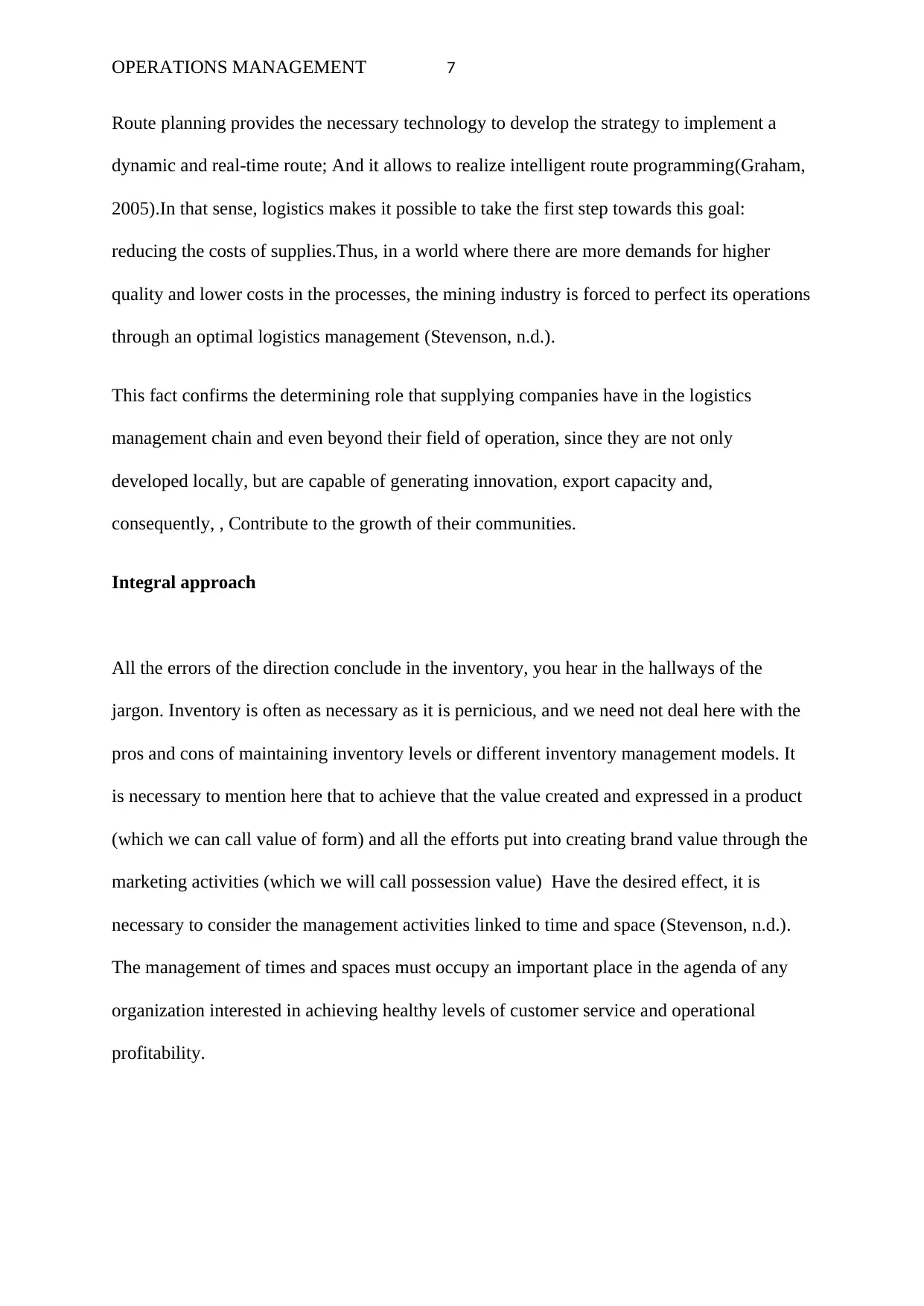
OPERATIONS MANAGEMENT 7
Route planning provides the necessary technology to develop the strategy to implement a
dynamic and real-time route; And it allows to realize intelligent route programming(Graham,
2005).In that sense, logistics makes it possible to take the first step towards this goal:
reducing the costs of supplies.Thus, in a world where there are more demands for higher
quality and lower costs in the processes, the mining industry is forced to perfect its operations
through an optimal logistics management (Stevenson, n.d.).
This fact confirms the determining role that supplying companies have in the logistics
management chain and even beyond their field of operation, since they are not only
developed locally, but are capable of generating innovation, export capacity and,
consequently, , Contribute to the growth of their communities.
Integral approach
All the errors of the direction conclude in the inventory, you hear in the hallways of the
jargon. Inventory is often as necessary as it is pernicious, and we need not deal here with the
pros and cons of maintaining inventory levels or different inventory management models. It
is necessary to mention here that to achieve that the value created and expressed in a product
(which we can call value of form) and all the efforts put into creating brand value through the
marketing activities (which we will call possession value) Have the desired effect, it is
necessary to consider the management activities linked to time and space (Stevenson, n.d.).
The management of times and spaces must occupy an important place in the agenda of any
organization interested in achieving healthy levels of customer service and operational
profitability.
Route planning provides the necessary technology to develop the strategy to implement a
dynamic and real-time route; And it allows to realize intelligent route programming(Graham,
2005).In that sense, logistics makes it possible to take the first step towards this goal:
reducing the costs of supplies.Thus, in a world where there are more demands for higher
quality and lower costs in the processes, the mining industry is forced to perfect its operations
through an optimal logistics management (Stevenson, n.d.).
This fact confirms the determining role that supplying companies have in the logistics
management chain and even beyond their field of operation, since they are not only
developed locally, but are capable of generating innovation, export capacity and,
consequently, , Contribute to the growth of their communities.
Integral approach
All the errors of the direction conclude in the inventory, you hear in the hallways of the
jargon. Inventory is often as necessary as it is pernicious, and we need not deal here with the
pros and cons of maintaining inventory levels or different inventory management models. It
is necessary to mention here that to achieve that the value created and expressed in a product
(which we can call value of form) and all the efforts put into creating brand value through the
marketing activities (which we will call possession value) Have the desired effect, it is
necessary to consider the management activities linked to time and space (Stevenson, n.d.).
The management of times and spaces must occupy an important place in the agenda of any
organization interested in achieving healthy levels of customer service and operational
profitability.
Paraphrase This Document
Need a fresh take? Get an instant paraphrase of this document with our AI Paraphraser
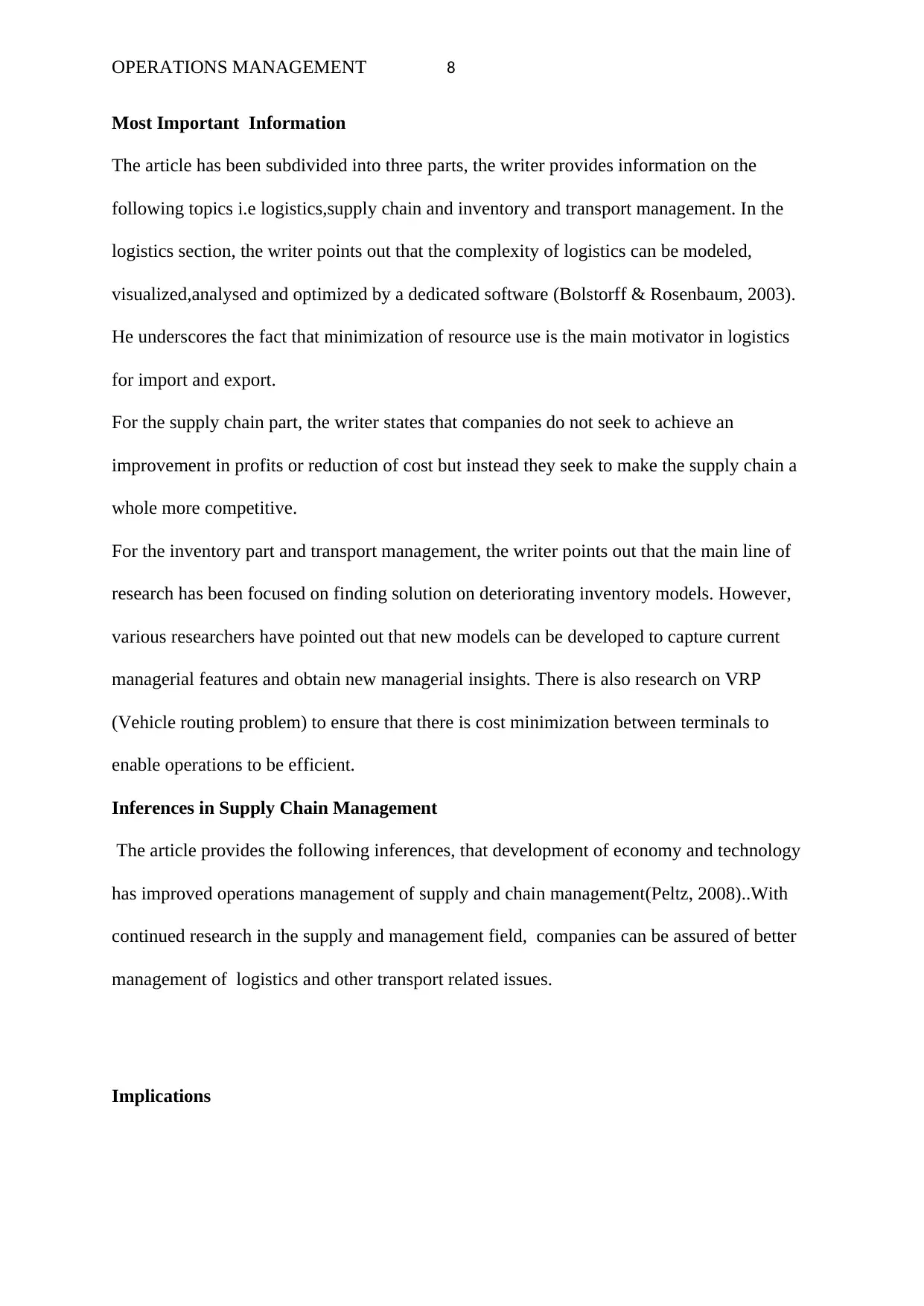
OPERATIONS MANAGEMENT 8
Most Important Information
The article has been subdivided into three parts, the writer provides information on the
following topics i.e logistics,supply chain and inventory and transport management. In the
logistics section, the writer points out that the complexity of logistics can be modeled,
visualized,analysed and optimized by a dedicated software (Bolstorff & Rosenbaum, 2003).
He underscores the fact that minimization of resource use is the main motivator in logistics
for import and export.
For the supply chain part, the writer states that companies do not seek to achieve an
improvement in profits or reduction of cost but instead they seek to make the supply chain a
whole more competitive.
For the inventory part and transport management, the writer points out that the main line of
research has been focused on finding solution on deteriorating inventory models. However,
various researchers have pointed out that new models can be developed to capture current
managerial features and obtain new managerial insights. There is also research on VRP
(Vehicle routing problem) to ensure that there is cost minimization between terminals to
enable operations to be efficient.
Inferences in Supply Chain Management
The article provides the following inferences, that development of economy and technology
has improved operations management of supply and chain management(Peltz, 2008)..With
continued research in the supply and management field, companies can be assured of better
management of logistics and other transport related issues.
Implications
Most Important Information
The article has been subdivided into three parts, the writer provides information on the
following topics i.e logistics,supply chain and inventory and transport management. In the
logistics section, the writer points out that the complexity of logistics can be modeled,
visualized,analysed and optimized by a dedicated software (Bolstorff & Rosenbaum, 2003).
He underscores the fact that minimization of resource use is the main motivator in logistics
for import and export.
For the supply chain part, the writer states that companies do not seek to achieve an
improvement in profits or reduction of cost but instead they seek to make the supply chain a
whole more competitive.
For the inventory part and transport management, the writer points out that the main line of
research has been focused on finding solution on deteriorating inventory models. However,
various researchers have pointed out that new models can be developed to capture current
managerial features and obtain new managerial insights. There is also research on VRP
(Vehicle routing problem) to ensure that there is cost minimization between terminals to
enable operations to be efficient.
Inferences in Supply Chain Management
The article provides the following inferences, that development of economy and technology
has improved operations management of supply and chain management(Peltz, 2008)..With
continued research in the supply and management field, companies can be assured of better
management of logistics and other transport related issues.
Implications
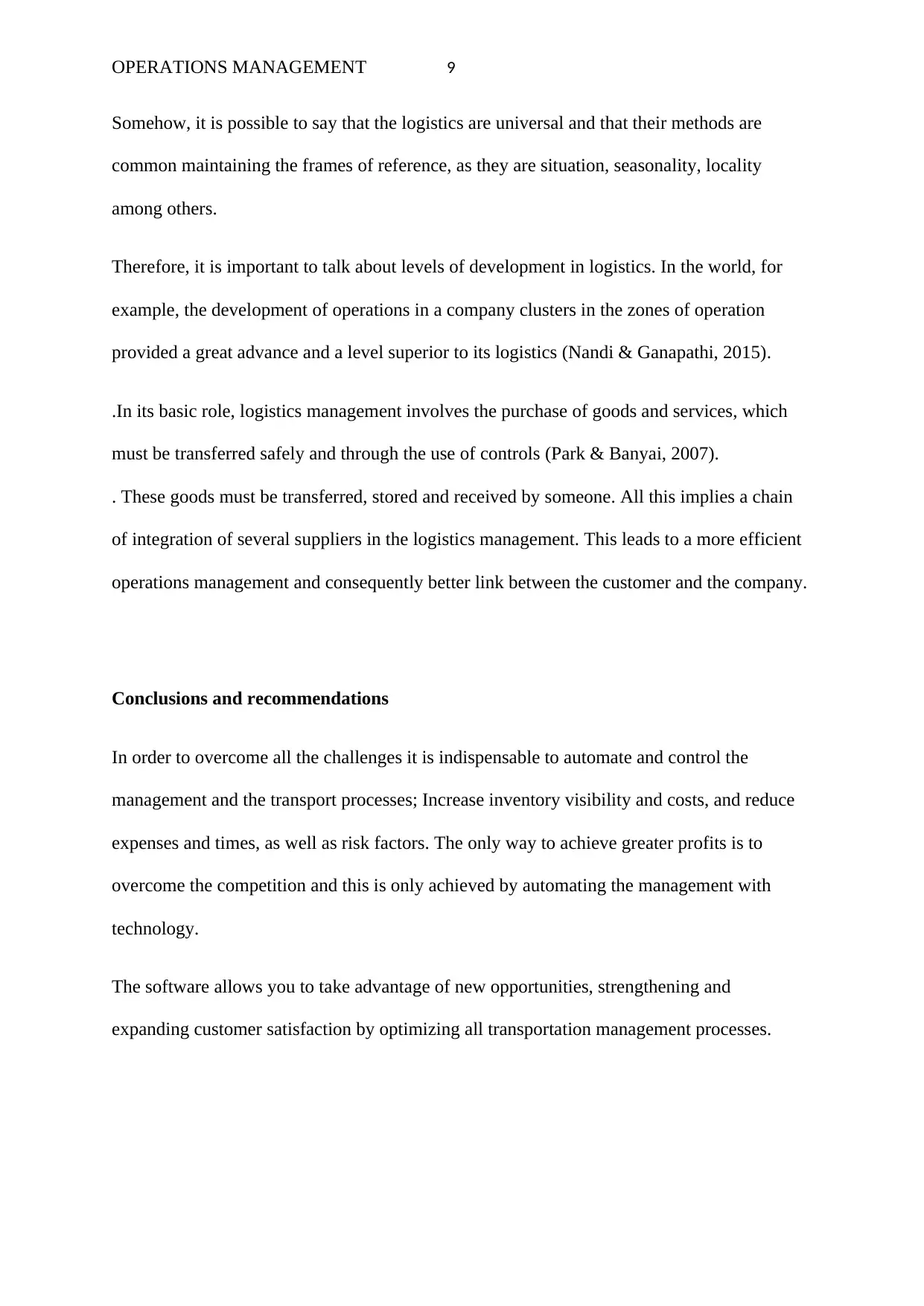
OPERATIONS MANAGEMENT 9
Somehow, it is possible to say that the logistics are universal and that their methods are
common maintaining the frames of reference, as they are situation, seasonality, locality
among others.
Therefore, it is important to talk about levels of development in logistics. In the world, for
example, the development of operations in a company clusters in the zones of operation
provided a great advance and a level superior to its logistics (Nandi & Ganapathi, 2015).
.In its basic role, logistics management involves the purchase of goods and services, which
must be transferred safely and through the use of controls (Park & Banyai, 2007).
. These goods must be transferred, stored and received by someone. All this implies a chain
of integration of several suppliers in the logistics management. This leads to a more efficient
operations management and consequently better link between the customer and the company.
Conclusions and recommendations
In order to overcome all the challenges it is indispensable to automate and control the
management and the transport processes; Increase inventory visibility and costs, and reduce
expenses and times, as well as risk factors. The only way to achieve greater profits is to
overcome the competition and this is only achieved by automating the management with
technology.
The software allows you to take advantage of new opportunities, strengthening and
expanding customer satisfaction by optimizing all transportation management processes.
Somehow, it is possible to say that the logistics are universal and that their methods are
common maintaining the frames of reference, as they are situation, seasonality, locality
among others.
Therefore, it is important to talk about levels of development in logistics. In the world, for
example, the development of operations in a company clusters in the zones of operation
provided a great advance and a level superior to its logistics (Nandi & Ganapathi, 2015).
.In its basic role, logistics management involves the purchase of goods and services, which
must be transferred safely and through the use of controls (Park & Banyai, 2007).
. These goods must be transferred, stored and received by someone. All this implies a chain
of integration of several suppliers in the logistics management. This leads to a more efficient
operations management and consequently better link between the customer and the company.
Conclusions and recommendations
In order to overcome all the challenges it is indispensable to automate and control the
management and the transport processes; Increase inventory visibility and costs, and reduce
expenses and times, as well as risk factors. The only way to achieve greater profits is to
overcome the competition and this is only achieved by automating the management with
technology.
The software allows you to take advantage of new opportunities, strengthening and
expanding customer satisfaction by optimizing all transportation management processes.
⊘ This is a preview!⊘
Do you want full access?
Subscribe today to unlock all pages.

Trusted by 1+ million students worldwide
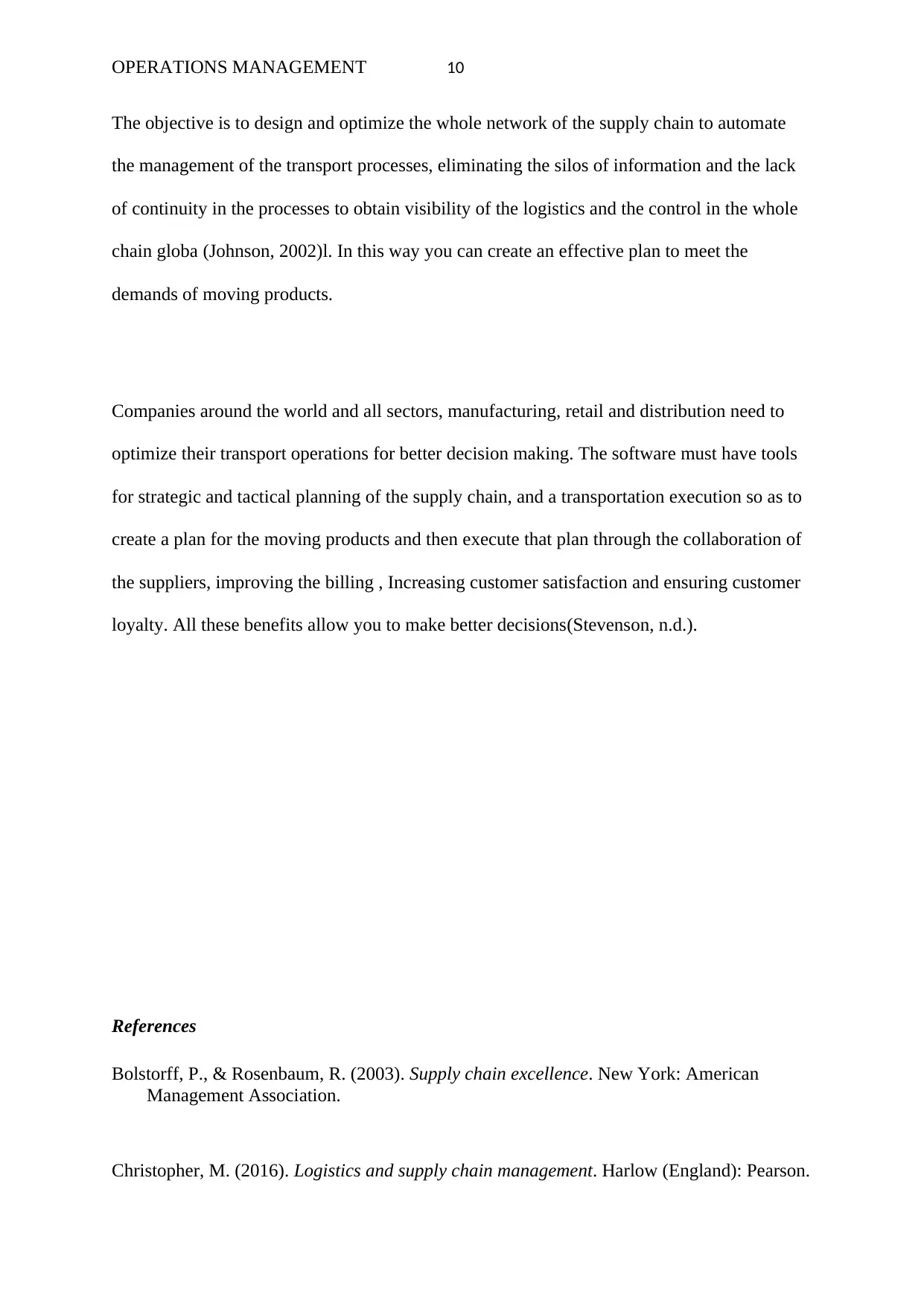
OPERATIONS MANAGEMENT 10
The objective is to design and optimize the whole network of the supply chain to automate
the management of the transport processes, eliminating the silos of information and the lack
of continuity in the processes to obtain visibility of the logistics and the control in the whole
chain globa (Johnson, 2002)l. In this way you can create an effective plan to meet the
demands of moving products.
Companies around the world and all sectors, manufacturing, retail and distribution need to
optimize their transport operations for better decision making. The software must have tools
for strategic and tactical planning of the supply chain, and a transportation execution so as to
create a plan for the moving products and then execute that plan through the collaboration of
the suppliers, improving the billing , Increasing customer satisfaction and ensuring customer
loyalty. All these benefits allow you to make better decisions(Stevenson, n.d.).
References
Bolstorff, P., & Rosenbaum, R. (2003). Supply chain excellence. New York: American
Management Association.
Christopher, M. (2016). Logistics and supply chain management. Harlow (England): Pearson.
The objective is to design and optimize the whole network of the supply chain to automate
the management of the transport processes, eliminating the silos of information and the lack
of continuity in the processes to obtain visibility of the logistics and the control in the whole
chain globa (Johnson, 2002)l. In this way you can create an effective plan to meet the
demands of moving products.
Companies around the world and all sectors, manufacturing, retail and distribution need to
optimize their transport operations for better decision making. The software must have tools
for strategic and tactical planning of the supply chain, and a transportation execution so as to
create a plan for the moving products and then execute that plan through the collaboration of
the suppliers, improving the billing , Increasing customer satisfaction and ensuring customer
loyalty. All these benefits allow you to make better decisions(Stevenson, n.d.).
References
Bolstorff, P., & Rosenbaum, R. (2003). Supply chain excellence. New York: American
Management Association.
Christopher, M. (2016). Logistics and supply chain management. Harlow (England): Pearson.
Paraphrase This Document
Need a fresh take? Get an instant paraphrase of this document with our AI Paraphraser
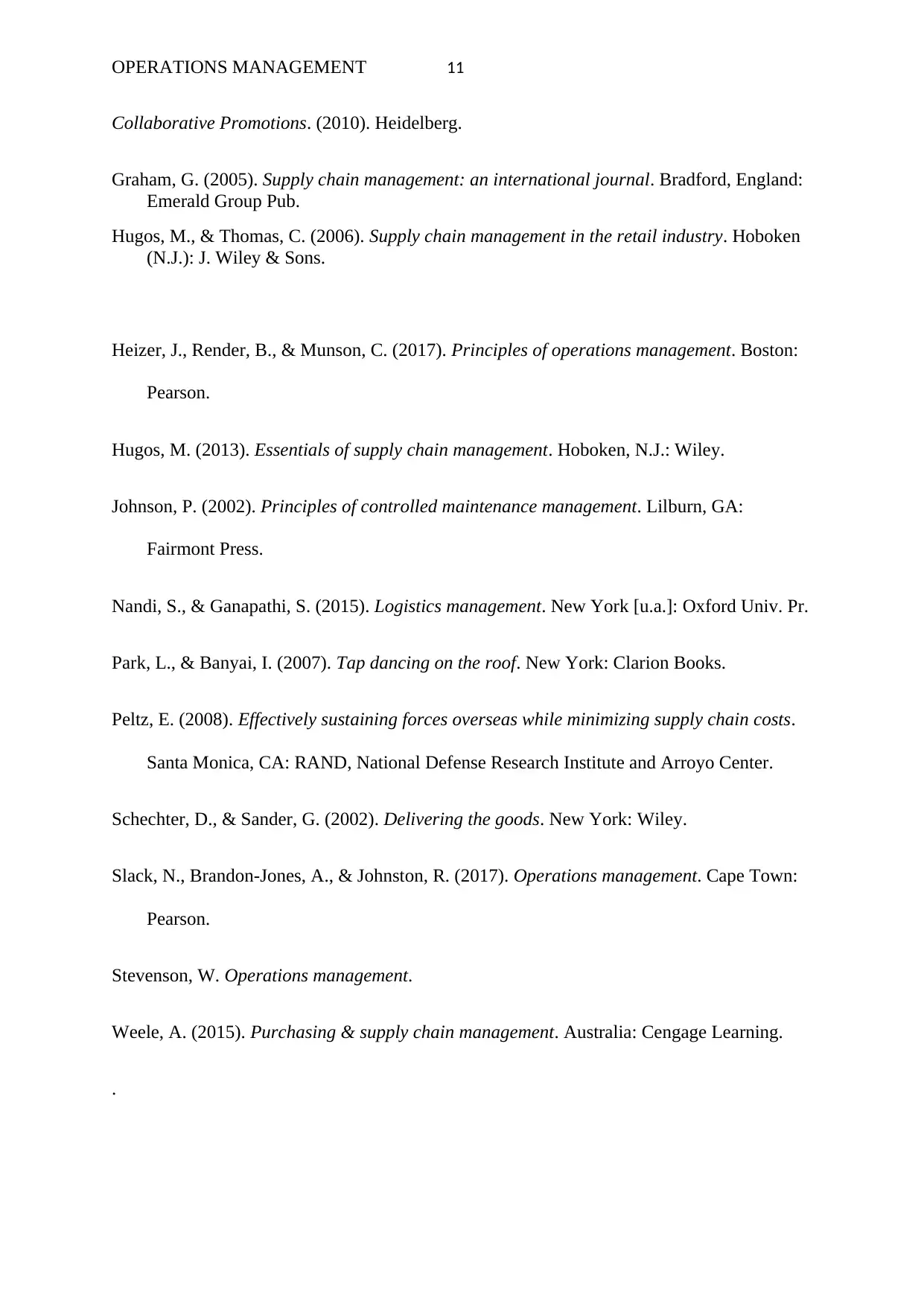
OPERATIONS MANAGEMENT 11
Collaborative Promotions. (2010). Heidelberg.
Graham, G. (2005). Supply chain management: an international journal. Bradford, England:
Emerald Group Pub.
Hugos, M., & Thomas, C. (2006). Supply chain management in the retail industry. Hoboken
(N.J.): J. Wiley & Sons.
Heizer, J., Render, B., & Munson, C. (2017). Principles of operations management. Boston:
Pearson.
Hugos, M. (2013). Essentials of supply chain management. Hoboken, N.J.: Wiley.
Johnson, P. (2002). Principles of controlled maintenance management. Lilburn, GA:
Fairmont Press.
Nandi, S., & Ganapathi, S. (2015). Logistics management. New York [u.a.]: Oxford Univ. Pr.
Park, L., & Banyai, I. (2007). Tap dancing on the roof. New York: Clarion Books.
Peltz, E. (2008). Effectively sustaining forces overseas while minimizing supply chain costs.
Santa Monica, CA: RAND, National Defense Research Institute and Arroyo Center.
Schechter, D., & Sander, G. (2002). Delivering the goods. New York: Wiley.
Slack, N., Brandon-Jones, A., & Johnston, R. (2017). Operations management. Cape Town:
Pearson.
Stevenson, W. Operations management.
Weele, A. (2015). Purchasing & supply chain management. Australia: Cengage Learning.
.
Collaborative Promotions. (2010). Heidelberg.
Graham, G. (2005). Supply chain management: an international journal. Bradford, England:
Emerald Group Pub.
Hugos, M., & Thomas, C. (2006). Supply chain management in the retail industry. Hoboken
(N.J.): J. Wiley & Sons.
Heizer, J., Render, B., & Munson, C. (2017). Principles of operations management. Boston:
Pearson.
Hugos, M. (2013). Essentials of supply chain management. Hoboken, N.J.: Wiley.
Johnson, P. (2002). Principles of controlled maintenance management. Lilburn, GA:
Fairmont Press.
Nandi, S., & Ganapathi, S. (2015). Logistics management. New York [u.a.]: Oxford Univ. Pr.
Park, L., & Banyai, I. (2007). Tap dancing on the roof. New York: Clarion Books.
Peltz, E. (2008). Effectively sustaining forces overseas while minimizing supply chain costs.
Santa Monica, CA: RAND, National Defense Research Institute and Arroyo Center.
Schechter, D., & Sander, G. (2002). Delivering the goods. New York: Wiley.
Slack, N., Brandon-Jones, A., & Johnston, R. (2017). Operations management. Cape Town:
Pearson.
Stevenson, W. Operations management.
Weele, A. (2015). Purchasing & supply chain management. Australia: Cengage Learning.
.

OPERATIONS MANAGEMENT 12
⊘ This is a preview!⊘
Do you want full access?
Subscribe today to unlock all pages.

Trusted by 1+ million students worldwide
1 out of 12
Related Documents
Your All-in-One AI-Powered Toolkit for Academic Success.
+13062052269
info@desklib.com
Available 24*7 on WhatsApp / Email
![[object Object]](/_next/static/media/star-bottom.7253800d.svg)
Unlock your academic potential
Copyright © 2020–2025 A2Z Services. All Rights Reserved. Developed and managed by ZUCOL.





